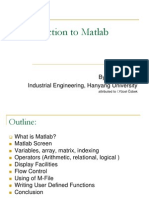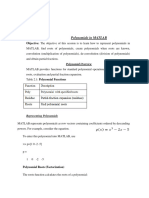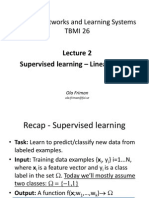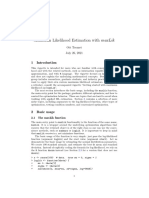MATLAB Optimization Toolbox
MATLAB Optimization Toolbox
Uploaded by
kushkhanna06Copyright:
Available Formats
MATLAB Optimization Toolbox
MATLAB Optimization Toolbox
Uploaded by
kushkhanna06Original Description:
Original Title
Copyright
Available Formats
Share this document
Did you find this document useful?
Is this content inappropriate?
Copyright:
Available Formats
MATLAB Optimization Toolbox
MATLAB Optimization Toolbox
Uploaded by
kushkhanna06Copyright:
Available Formats
MATLAB Optimization
Toolbox
Presentation Outline
Introduction
Function Optimization
Optimization Toolbox
Routines / Algorithms available
Optimization Problems
Unconstrained
Constrained
Example
The Algorithm Description
Function Optimization
Optimization concerns the
minimization or maximization of
functions
Standard Optimization Problem
( )
~
~
min
x
f x
( )
~
0
j
g x s
( )
~
0
i
h x =
L U
k k k
x x x s s
Equality Constraints
Subject to:
Inequality Constraints
Side Constraints
Function Optimization
( )
~
f x is the objective function, which measure
and evaluate the performance of a system.
In a standard problem, we are minimizing
the function.
For maximization, it is equivalent to minimization
of the ve of the objective function.
~
x
is a column vector of design variables, which can
affect the performance of the system.
Function Optimization
Constraints Limitation to the design space.
Can be linear or nonlinear, explicit or implicit functions
( )
~
0
j
g x s
( )
~
0
i
h x =
L U
k k k
x x x s s
Equality Constraints
Inequality Constraints
Side Constraints
Most algorithm require less than!!!
Optimization Toolbox
Is a collection of functions that extend the capability of
MATLAB. The toolbox includes routines for:
Unconstrained optimization
Constrained nonlinear optimization, including goal
attainment problems, minimax problems, and semi-
infinite minimization problems
Quadratic and linear programming
Nonlinear least squares and curve fitting
Nonlinear systems of equations solving
Constrained linear least squares
Specialized algorithms for large scale problems
Minimization Algorithm
Minimization Algorithm (Cont.)
Equation Solving Algorithms
Least-Squares Algorithms
Implementing Opt. Toolbox
Most of these optimization routines require
the definition of an M-file containing the
function, f, to be minimized.
Maximization is achieved by supplying the
routines with f.
Optimization options passed to the routines
change optimization parameters.
Default optimization parameters can be
changed through an options structure.
Unconstrained Minimization
Consider the problem of finding a set
of values [x
1
x
2
]
T
that solves
( )
( )
1
~
2 2
1 2 1 2 2
~
min 4 2 4 2 1
x
x
f x e x x x x x = + + + +
| |
1 2
~
T
x x x =
Steps
Create an M-file that returns the
function value (Objective Function)
Call it objfun.m
Then, invoke the unconstrained
minimization routine
Use fminunc
Step 1 Obj. Function
function f = objfun(x)
f=exp(x(1))*(4*x(1)^2+2*x(2)^2+4*x(1)*x(2)+2*x(2)+1);
| |
1 2
~
T
x x x =
Objective function
Step 2 Invoke Routine
x0 = [-1,1];
options = optimset(LargeScale,off);
[xmin,feval,exitflag,output]=
fminunc(objfun,x0,options);
Output arguments
Input arguments
Starting with a guess
Optimization parameters settings
Results
xmin =
0.5000 -1.0000
feval =
1.3028e-010
exitflag =
1
output =
iterations: 7
funcCount: 40
stepsize: 1
firstorderopt: 8.1998e-004
algorithm: 'medium-scale: Quasi-Newton line search'
Minimum point of design variables
Objective function value
Exitflag tells if the algorithm is converged.
If exitflag > 0, then local minimum is found
Some other information
More on fminunc Input
[xmin,feval,exitflag,output,grad,hessian]=
fminunc(fun,x0,options,P1,P2,)
fun: Return a function of objective function.
x0: Starts with an initial guess. The guess must be a vector of size of
number of design variables.
option: To set some of the optimization parameters. (More after few
slides)
P1,P2,: To pass additional parameters.
More on fminunc Output
[xmin,feval,exitflag,output,grad,hessian]=
fminunc(fun,x0,options,P1,P2,)
xmin: Vector of the minimum point (optimal point). The size is the
number of design variables.
feval: The objective function value of at the optimal point.
exitflag: A value shows whether the optimization routine is
terminated successfully. (converged if >0)
output: This structure gives more details about the optimization
grad: The gradient value at the optimal point.
hessian: The hessian value of at the optimal point
Options Setting optimset
Options =
optimset(param1,value1, param2,value2,)
The routines in Optimization Toolbox has a set of default optimization
parameters.
However, the toolbox allows you to alter some of those parameters,
for example: the tolerance, the step size, the gradient or hessian
values, the max. number of iterations etc.
There are also a list of features available, for example: displaying the
values at each iterations, compare the user supply gradient or
hessian, etc.
You can also choose the algorithm you wish to use.
Options Setting (Cont.)
Options =
optimset(param1,value1, param2,value2,)
Type help optimset in command window, a list of options setting
available will be displayed.
How to read? For example:
LargeScale - Use large-scale algorithm if
possible [ {on} | off ]
The default is with { }
Parameter (param1)
Value (value1)
Options Setting (Cont.)
LargeScale - Use large-scale algorithm if
possible [ {on} | off ]
Since the default is on, if we would like to turn off, we just type:
Options =
optimset(LargeScale, off)
Options =
optimset(param1,value1, param2,value2,)
and pass to the input of fminunc.
Useful Option Settings
Display - Level of display [ off | iter |
notify | final ]
MaxIter - Maximum number of iterations
allowed [ positive integer ]
TolCon - Termination tolerance on the
constraint violation [ positive scalar ]
TolFun - Termination tolerance on the
function value [ positive scalar ]
TolX - Termination tolerance on X [ positive
scalar ]
Highly recommended to use!!!
fminunc and fminsearch
fminunc uses algorithm with gradient
and hessian information.
Two modes:
Large-Scale: interior-reflective Newton
Medium-Scale: quasi-Newton (BFGS)
Not preferred in solving highly
discontinuous functions.
This function may only give local solutions.
fminunc and fminsearch
fminsearch is generally less efficient than
fminunc for problems of order greater than
two. However, when the problem is highly
discontinuous, fminsearch may be more
robust.
This is a direct search method that does not
use numerical or analytic gradients as in
fminunc.
This function may only give local solutions.
Constrained Minimization
[xmin,feval,exitflag,output,lambda,grad,hessian]
=
fmincon(fun,x0,A,B,Aeq,Beq,LB,UB,NONLCON,options,
P1,P2,)
Vector of Lagrange
Multiplier at optimal
point
Example
( )
~
1 2 3
~
min
x
f x x x x =
2
1 2
2 0 x x + s
1 2 3
1 2 3
2 2 0
2 2 72
x x x
x x x
s
+ + s
1 2 3
0 , , 30 x x x s s
Subject to:
1 2 2 0
,
1 2 2 72
A B
( (
= =
( (
0 30
0 , 30
0 30
LB UB
( (
( (
= =
( (
( (
function f = myfun(x)
f=-x(1)*x(2)*x(3);
Example (Cont.)
2
1 2
2 0 x x + s
For
Create a function call nonlcon which returns 2 constraint vectors [C,Ceq]
function [C,Ceq]=nonlcon(x)
C=2*x(1)^2+x(2);
Ceq=[];
Remember to return a null
Matrix if the constraint does
not apply
Example (Cont.)
x0=[10;10;10];
A=[-1 -2 -2;1 2 2];
B=[0 72]';
LB = [0 0 0]';
UB = [30 30 30]';
[x,feval]=fmincon(@myfun,x0,A,B,[],[],LB,UB,@nonlcon)
1 2 2 0
,
1 2 2 72
A B
( (
= =
( (
Initial guess (3 design variables)
CAREFUL!!!
fmincon(fun,x0,A,B,Aeq,Beq,LB,UB,NONLCON,options,P1,P2,)
0 30
0 , 30
0 30
LB UB
( (
( (
= =
( (
( (
Example (Cont.)
Warning: Large-scale (trust region) method does not currently solve this type of problem, switching to
medium-scale (line search).
> In D:\Programs\MATLAB6p1\toolbox\optim\fmincon.m at line 213
In D:\usr\CHINTANG\OptToolbox\min_con.m at line 6
Optimization terminated successfully:
Magnitude of directional derivative in search direction less than 2*options.TolFun and maximum constraint
violation is less than options.TolCon
Active Constraints:
2
9
x =
0.00050378663220
0.00000000000000
30.00000000000000
feval =
-4.657237250542452e-035
2
1 2
2 0 x x + s
1 2 3
1 2 3
2 2 0
2 2 72
x x x
x x x
s
+ + s
1
2
3
0 30
0 30
0 30
x
x
x
s s
s s
s s
Const. 1
Const. 2
Const. 3
Const. 4
Const. 5
Const. 6
Const. 7
Sequence: A,B,Aeq,Beq,LB,UB,C,Ceq
Const. 8
Const. 9
Solving Linear Programs:
MATLAB uses the following format for
linear programs:
A linear program in the above format is
solved using the command:
x = linprog(f ;A; b;Aeq; beq; l; u):
Simple LP Example:
Suppose we want to solve the following
linear program using MATLAB:
Convert the LP into MATLAB format:
Simple LP Example cont
Input the variables into Matlab:
>> f = -[4;2;1];
>> A = [2 1 0;1 0 2];
>> b = [1;2];
Aeq = [1 1 1];
beq = [1];
l = [0;0;0];
u = [1;1;2];
Simple LP Example cont
Solve the linear program using MATLAB:
>> x = linprog(f,A,b,Aeq,beq,l,u)
And you should get:
x =
0.5000
0.0000
0.5000
Simple LP Example cont
What to do when some of the variables are
missing?
For example, suppose that no lower bounds on the variables. In this case
define l to be the empty set using the MATLAB command:
>> l = [ ];
Doing this and resolving the LP gives:
x =
0.6667
-0.3333
0.6667
Simple LP Example cont
Define other matrices to be empty matrices if they
do not appear in the problem formulation. For
example, if there are no equality constraints, define
Aeq and beq as empty sets, i.e.
>> Aeq = [ ];
>> beq = [ ];
Solution becomes:
X =
0.0000
1.0000
1.0000
Sensitivity Analysis:
How sensitive are optimal solutions to
errors in data, model parameters, and
changes to inputs in the linear
programming problem?
Sensitivity analysis is important
because it enables flexibility and
adaptation to changing conditions
Conclusion
Easy to use! But, we do not know what is happening behind
the routine. Therefore, it is still important to understand the
limitation of each routine.
Basic steps:
Recognize the class of optimization problem
Define the design variables
Create objective function
Recognize the constraints
Start an initial guess
Invoke suitable routine
Analyze the results (it might not make sense)
You might also like
- 02 Huong DanDocument37 pages02 Huong Dankhanhvo070373No ratings yet
- OptimizationDocument38 pagesOptimizationt2jzgeNo ratings yet
- An Introduction To An Introduction To Optimization Optimization Using Using Evolutionary Algorithms Evolutionary AlgorithmsDocument45 pagesAn Introduction To An Introduction To Optimization Optimization Using Using Evolutionary Algorithms Evolutionary AlgorithmsSai Naga Sri HarshaNo ratings yet
- MATLAB Tutorial: MATLAB Basics & Signal Processing ToolboxDocument47 pagesMATLAB Tutorial: MATLAB Basics & Signal Processing ToolboxSaeed Mahmood Gul KhanNo ratings yet
- Practical Lesson 4. Constrained Optimization: Degree in Data ScienceDocument6 pagesPractical Lesson 4. Constrained Optimization: Degree in Data ScienceIvan AlexandrovNo ratings yet
- Introduction To Matlab: By: Kichun Lee Industrial Engineering, Hanyang UniversityDocument34 pagesIntroduction To Matlab: By: Kichun Lee Industrial Engineering, Hanyang UniversityEvans Krypton SowahNo ratings yet
- Scilab Optimization 201109Document6 pagesScilab Optimization 201109Yusuf HaqiqzaiNo ratings yet
- Introduction To Matlab: By: İ.Yücel ÖzbekDocument34 pagesIntroduction To Matlab: By: İ.Yücel Özbekbagde_manoj7No ratings yet
- Matlab Tutorial2Document20 pagesMatlab Tutorial2dlathdbs64No ratings yet
- Optimization Presentation 2015Document80 pagesOptimization Presentation 2015fnagiNo ratings yet
- Mathcad13 - New FeaturesDocument8 pagesMathcad13 - New FeaturescutefrenzyNo ratings yet
- Lab 2Document14 pagesLab 2Tahsin Zaman TalhaNo ratings yet
- Matlab OverviewDocument11 pagesMatlab OverviewAhmad HosseinbeigNo ratings yet
- Unit-2 Functions (E-Next - In)Document40 pagesUnit-2 Functions (E-Next - In)addk572No ratings yet
- Lagrange Multiplier - Using - FminconDocument3 pagesLagrange Multiplier - Using - FminconAleyna BozkurtNo ratings yet
- EC106 Advance Digital Signal Processing Lab Manual On Digital Signal ProcessingDocument69 pagesEC106 Advance Digital Signal Processing Lab Manual On Digital Signal ProcessingSHARAD FADADU0% (1)
- MATLAB MATLAB Lab Manual Numerical Methods and MatlabDocument14 pagesMATLAB MATLAB Lab Manual Numerical Methods and MatlabJavaria Chiragh80% (5)
- Mat Lab Opt ToolboxDocument14 pagesMat Lab Opt ToolboxNANKADAVUL007No ratings yet
- Matlab Review PDFDocument19 pagesMatlab Review PDFMian HusnainNo ratings yet
- Optimization For DummiesDocument5 pagesOptimization For DummiesMauricio BedoyaNo ratings yet
- S&S Lab 1 HandoutDocument11 pagesS&S Lab 1 HandoutZameer HussainNo ratings yet
- Introduction To MatlabDocument34 pagesIntroduction To MatlabHaseeb BalochNo ratings yet
- Labs-TE Lab Manual DSPDocument67 pagesLabs-TE Lab Manual DSPAntony John BrittoNo ratings yet
- Introduction Ao MatlabDocument52 pagesIntroduction Ao MatlabMiquéias Do Prado GuimarãesNo ratings yet
- Python Programming Unit Ii: Prof - Ajay Pashankar Assistant Professor Department of Cs & It K.M.Agrawal College KalyanDocument58 pagesPython Programming Unit Ii: Prof - Ajay Pashankar Assistant Professor Department of Cs & It K.M.Agrawal College KalyanPrathameshNo ratings yet
- Ga-MatlabDocument19 pagesGa-MatlabMaham AkramNo ratings yet
- Find Minimum of Unconstrained Multivariable Function Using Derivative-Free Method - MATLAB FminsearchDocument5 pagesFind Minimum of Unconstrained Multivariable Function Using Derivative-Free Method - MATLAB FminsearchCristian Giovanny Gomez OlarteNo ratings yet
- SVMDocument36 pagesSVMHimanshu BhattNo ratings yet
- 1 Introduction To MatlabDocument17 pages1 Introduction To MatlabFizza ShaikhNo ratings yet
- FminconDocument3 pagesFminconБогдан КулиничNo ratings yet
- Lab-2-Course Matlab Manual For LCSDocument12 pagesLab-2-Course Matlab Manual For LCSAshno KhanNo ratings yet
- SOT MethodDocument9 pagesSOT Methoduazeez478No ratings yet
- Lab Session 01Document11 pagesLab Session 01abdul wakeelNo ratings yet
- Lecture 2 MathDocument34 pagesLecture 2 Mathnikola001No ratings yet
- MIT6 094IAP10 Lec03Document40 pagesMIT6 094IAP10 Lec03skh_1987No ratings yet
- Lab Report MatlabDocument43 pagesLab Report MatlabRana Hamza Muhammad YousafNo ratings yet
- Lab Sheet 00 Introduction To MATLABDocument9 pagesLab Sheet 00 Introduction To MATLABSREELEKHA K RNo ratings yet
- An Introduction To Matlab: Kocaeli University Assist. Prof. Dr. Osman Büyük Digital Signal Processing ApplicationsDocument37 pagesAn Introduction To Matlab: Kocaeli University Assist. Prof. Dr. Osman Büyük Digital Signal Processing ApplicationsMd.Arifur RahmanNo ratings yet
- Using MaxlikDocument20 pagesUsing MaxlikJames HotnielNo ratings yet
- Matlab OptimizationDocument14 pagesMatlab Optimizationela arasuNo ratings yet
- Introduction To MATLAB: Getting Started With MATLABDocument8 pagesIntroduction To MATLAB: Getting Started With MATLABfrend_bbbNo ratings yet
- Shivam Mishra (1508260) Shashikant Kumar (1508259) Rajinish Kumar (1508253)Document28 pagesShivam Mishra (1508260) Shashikant Kumar (1508259) Rajinish Kumar (1508253)Shivam MishraNo ratings yet
- Outline: Simultaneous Nonlinear Algebraic Equations October 10, 2012Document4 pagesOutline: Simultaneous Nonlinear Algebraic Equations October 10, 2012elcboyNo ratings yet
- Scientific Computing: Optimization Toolbox Nonlinear Equations, Numerical OptimizationDocument45 pagesScientific Computing: Optimization Toolbox Nonlinear Equations, Numerical OptimizationmortezagashtiNo ratings yet
- Lab Exp 1Document16 pagesLab Exp 1NumanAbdullah100% (1)
- Image ProcessingDocument36 pagesImage ProcessingTapasRoutNo ratings yet
- MAT 275 Laboratory 1 Introduction To MATLABDocument9 pagesMAT 275 Laboratory 1 Introduction To MATLABAditya NairNo ratings yet
- Matlab Intro MarshDocument12 pagesMatlab Intro Marshlunatiko21No ratings yet
- Nonlinear Systems ScilabDocument12 pagesNonlinear Systems ScilabCarlos Soza RossNo ratings yet
- Lecture 11 - FunctionsDocument17 pagesLecture 11 - FunctionsOnee Yetoo AseemeNo ratings yet
- DIRECT Optimization Algorithm User GuideDocument14 pagesDIRECT Optimization Algorithm User GuideMostafa MangalNo ratings yet
- Python Unit2Document57 pagesPython Unit2KFYBsc IT 052 Nihar NegandhiNo ratings yet
- Exercises Lecture 1: ExerciseDocument7 pagesExercises Lecture 1: ExerciseAnass AloulouNo ratings yet
- A Brief Introduction to MATLAB: Taken From the Book "MATLAB for Beginners: A Gentle Approach"From EverandA Brief Introduction to MATLAB: Taken From the Book "MATLAB for Beginners: A Gentle Approach"Rating: 2.5 out of 5 stars2.5/5 (2)
- MATLAB for Beginners: A Gentle Approach - Revised EditionFrom EverandMATLAB for Beginners: A Gentle Approach - Revised EditionRating: 3.5 out of 5 stars3.5/5 (11)
- Programming with MATLAB: Taken From the Book "MATLAB for Beginners: A Gentle Approach"From EverandProgramming with MATLAB: Taken From the Book "MATLAB for Beginners: A Gentle Approach"Rating: 4.5 out of 5 stars4.5/5 (3)
- BLD 401 - Module 4Document15 pagesBLD 401 - Module 4Ijadunola John BelovedNo ratings yet
- Lesson Plan 2GSSDDocument4 pagesLesson Plan 2GSSDkiransreeNo ratings yet
- Addition Subtraction Strategies 2Document2 pagesAddition Subtraction Strategies 2tizuliveNo ratings yet
- Dokumen - Pub Optimal Control Theory An Introduction Solution Manual 9780486434841 0 486 43484 2Document185 pagesDokumen - Pub Optimal Control Theory An Introduction Solution Manual 9780486434841 0 486 43484 2Siddharth UNo ratings yet
- Online Instructions For Chapter 2: Divide-And-Conquer: Algorithms Analysis and Design (CO3031)Document20 pagesOnline Instructions For Chapter 2: Divide-And-Conquer: Algorithms Analysis and Design (CO3031)Trần Quốc KhangNo ratings yet
- TUGAS BESAR Pemodelan Optimasi S2Document2 pagesTUGAS BESAR Pemodelan Optimasi S2soniyoraNo ratings yet
- Real Time Scheduling AlgorithmDocument24 pagesReal Time Scheduling AlgorithmamarNo ratings yet
- Iii Year Numerical Practical Questions-1Document14 pagesIii Year Numerical Practical Questions-1narasaiahp888777No ratings yet
- 18 Syed Kamruddin Ahamed Final PaperDocument16 pages18 Syed Kamruddin Ahamed Final PaperiisteNo ratings yet
- Numerical MethodsDocument20 pagesNumerical MethodsTousif MahbubNo ratings yet
- CP Algo PDFDocument440 pagesCP Algo PDFHasin Apurbo50% (8)
- Chapter3 ProblemSolvingBySearchingDocument61 pagesChapter3 ProblemSolvingBySearchingimehedi357No ratings yet
- ML Unit 3Document40 pagesML Unit 3Tharun KumarNo ratings yet
- 2072 4119 1 SMDocument5 pages2072 4119 1 SMVijay ManiNo ratings yet
- Igital Lead Compensator Using MATLAB Matlab: Department of Electronics EngineeringDocument10 pagesIgital Lead Compensator Using MATLAB Matlab: Department of Electronics EngineeringKARAN HARJAINo ratings yet
- Lab 1 - Machine Learning with Python - ML Engineering مهمDocument10 pagesLab 1 - Machine Learning with Python - ML Engineering مهمDr. Ahmed Khazal احمد خزعلNo ratings yet
- Butterworth FilterDocument6 pagesButterworth FilterSatish KumarNo ratings yet
- Unit-4 AdsDocument31 pagesUnit-4 AdsRohit Kumar100% (1)
- Iir FilterDocument10 pagesIir FilterSurajSinghNo ratings yet
- .Ir. All PracsDocument19 pages.Ir. All PracsJustin SebastianNo ratings yet
- Homework For Module 3 Part 1 PDFDocument3 pagesHomework For Module 3 Part 1 PDFSai Chaitanya GudariNo ratings yet
- Linear Regression in PythonDocument28 pagesLinear Regression in PythonEphremNo ratings yet
- Experiment No. 2 AIM:-Write A MATLAB Program To Generate Standard Discrete Time Signals andDocument9 pagesExperiment No. 2 AIM:-Write A MATLAB Program To Generate Standard Discrete Time Signals andKissan PortalNo ratings yet
- Ds 11Document21 pagesDs 11DilipNo ratings yet
- Tic Tac ToeDocument12 pagesTic Tac Toeindrajeet007No ratings yet
- AMCAT Hash Tables QuestionsDocument3 pagesAMCAT Hash Tables Questionsgsouvik4No ratings yet
- 18ECL57Document34 pages18ECL57KiranaItaagi “Kiran Itagi”No ratings yet
- Bres Mid Point CircleDocument3 pagesBres Mid Point CircleSwagato BhattacharyaNo ratings yet
- EC409 Control Systems (CareerYuga)Document3 pagesEC409 Control Systems (CareerYuga)jinto0007No ratings yet
- Assignment 6 - Initial Value Problems - Attempt Review - EconcordiaDocument17 pagesAssignment 6 - Initial Value Problems - Attempt Review - EconcordiaRimNo ratings yet

























































































